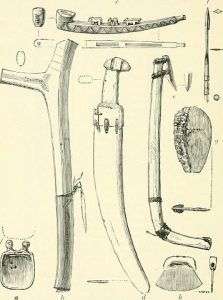Native Alaskan craftsmen and women who legally carve marine mammal ivory for a living have seen revenues reduced by 40% as a result of consumer confusion about new federal laws on elephant ivory – and a new California law that prohibits trade in marine mammal ivory. Melanie Bahnke, who heads a craft nonprofit for artisans the Bering Strait region, told NPR that she had arranged a craft fair in Nome for a luxury cruise ship last summer, but no one bought anything. “Once they realized something was made out of ivory you could tell that there was almost disdain, a look of disdain,” she said. The results are devastating for Native artisans who depend on sales of carved marine mammal ivory – particularly walrus – to pay for necessities like fuel oil through the winter.
Native Alaskan craftsmen already work within the parameters of the Marine Mammal Protection Act of 1972, amended in 1994. The MMPA is a federal law that protects sea otter, walrus, polar bear, dugong, and manatee, but has exceptions for marine mammal ivory carved by Alaska Natives.*
Aggressive federal laws prohibiting interstate transportation and sales of virtually all ivory apply only to elephant ivory, and according to Elly Pepper of the Natural Resources Defense Council, were not intended to disrupt Native economies. The scope and intent of the new federal ivory laws has apparently not been well understood by consumers, however, or by state legislators who have imposed even stricter state laws in California, New York, and other US states.
California’s complete ban of sales of ivory includes marine mammal ivory; section 2011(1)(B)(2) states, “(2) “Ivory” means a tooth or tusk from a species of elephant, hippopotamus, mammoth, mastodon, walrus, warthog, whale, or narwhal, or a piece thereof, whether raw ivory or worked ivory, and includes a product containing, or advertised as containing, ivory. Banning sales of marine mammal ivory in California (which is legal in all other states) was allegedly done to prevent sales of elephant ivory from being disguised as marine mammal.
(Similarly negative consequences of consumer misunderstandings are likely to result from proposed laws now before Congress that affect trade and export of other Native American art and artifacts, such as S. 3127/H. 5854, the Safeguard Tribal Objects of Patrimony Act of 2016 (or STOP Act). The STOP Act lumps together every definition of a “cultural object” from US law, adds an anti-export provision to NAGPRA without clearly identifying which items cannot be exported, and creates a 2-year amnesty that puts the burden of identifying items as ‘cultural patrimony’ on collectors and art dealers, when after 25 years of NAGPRA, museums still can’t agree on what those should be.)
Federal law has banned all interstate commercial trade in elephant ivory, with narrow exceptions under the Code of Federal Regulations, Vol. 50, Section 17.40(e). This final rule is administered by the Fish & Wildlife Services. It builds on and expands restrictions already in place under the African Elephant Conservation Act of 1989 (AfECA). The AfECA imposed a moratorium on importing most African elephant ivory into the United States or exporting African elephant ivory out of the United States. The final rule now in effect, in conjunction with AfECA and ESA, provides very limited exceptions for importing or exporting ivory to or from the United States, and for interstate sale of ivory.
The exceptions subject in part to Fish & Wildlife Services’ discretion and apply in regard to export of antique ivory (16 U.S.C. § 1539(h)(l)(A)-(D). The burden of proof is high, may require outside experts and scientific testing, and is entirely on the importer), for non-commercial transportation of musical instruments containing ivory, and a de minimis exception (50 CFR § 17.40(e)(3)) that permits interstate trade (no import or export) in objects are only partially of ivory and that meet seven specific criteria. Additional exceptions are related to traveling exhibitions, law enforcement and scientific purposes, household moves, and sport hunted trophies.
* The Marine Mammal Protection Act prohibits the taking and trading of marine mammals and their products but allows certain exemptions under State management. New marine mammal ivory may be carved only by Alaska Natives and sold only after it has been carved. Old ivory can be carved by non-Natives. Fossilized mammoth ivory may be used by both Alaska Natives and non-Natives. Beach-found ivory is legal to own if registered, but cannot be bartered or sold. Fossil ivory may not be collected on any State or federal lands but may be collected on private lands with permission of the owner.

Ivory Carvings, Photo By Mike Beauregard from Nunavut, Canada (Arctic Ivory) [CC BY 2.0 (http://creativecommons.org/licenses/by/2.0)], via Wikimedia Commons
 King Island Eskimos Carving Ivory Near Nome, 1 September 1949, By Haddon, E.P. (U.S. Fish and Wildlife Service url) [Public domain], via Wikimedia Commons; Handbook to the ethnographical collections, British Museum. Dept. of British and Mediaeval Antiquities and Ethnography, 1910, By Internet Archive Book Images [No restrictions], via Wikimedia Commons
King Island Eskimos Carving Ivory Near Nome, 1 September 1949, By Haddon, E.P. (U.S. Fish and Wildlife Service url) [Public domain], via Wikimedia Commons; Handbook to the ethnographical collections, British Museum. Dept. of British and Mediaeval Antiquities and Ethnography, 1910, By Internet Archive Book Images [No restrictions], via Wikimedia Commons 

